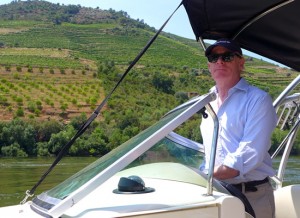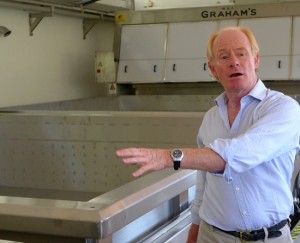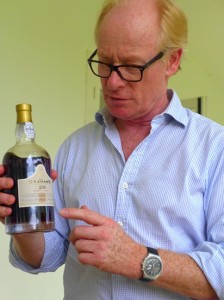 The fourth generation of the Symington clan that came to Portugal in 1882, Dominic Symington is one of a passel of cousins who run the wide-ranging port empire that includes Cockburn’s, Warre’s, Dow’s, and Graham’s, along with Quinto do Vesúvio and Altano table wines. When a group of us touring wine estates in the Douro Valley stopped in Pinhao to see the amazing tile murals at the train station (like the one above), Symington offered to pick us up for lunch – by boat.
The fourth generation of the Symington clan that came to Portugal in 1882, Dominic Symington is one of a passel of cousins who run the wide-ranging port empire that includes Cockburn’s, Warre’s, Dow’s, and Graham’s, along with Quinto do Vesúvio and Altano table wines. When a group of us touring wine estates in the Douro Valley stopped in Pinhao to see the amazing tile murals at the train station (like the one above), Symington offered to pick us up for lunch – by boat. 
We met him at the town dock, where one of his daughters and a friend were helping him dock his small speedboat. “It’s much faster than driving on the road,” he shrugged, as we sped a half hour upriver to the Quinta dos Malvedos of the Graham’s port company. He was particularly keen to show us the technology – first the traditional concrete lagars in which port grapes are pressed by foot. “This is wine as it was made in Biblical times,” he said. “If Caesar’s legion came marching in at harvest time, they would know just what to do – to climb in the lagar and start marching back and forth.”
There are tremendous advantages to this type of grape treading. The human foot crushes the skins just about perfectly to extract the deep color and the phenolic tannins that a wine like port needs to be full bodied and age well. The system has disadvantages, too, particularly when it comes to temperature control. Over the three weeks of harvest and crushing for port, the concrete warms up a lot from the combination of human body temperature and chemical reactions during the fermentation.
 Enter the Symington clan’s robotic treader: The lagars (troughs about knee deep) are replaced with stainless steel trays only slightly larger. Heating and cooling elements in the sides keep the fermentation temperature under control. And a robotic treader – with foot-sized pistons coated with silicon rubber – replaces the grape stompers by providing exactly the same pressure are the human foot (for geek readers, that’s 20 kg per square centimeter).
Enter the Symington clan’s robotic treader: The lagars (troughs about knee deep) are replaced with stainless steel trays only slightly larger. Heating and cooling elements in the sides keep the fermentation temperature under control. And a robotic treader – with foot-sized pistons coated with silicon rubber – replaces the grape stompers by providing exactly the same pressure are the human foot (for geek readers, that’s 20 kg per square centimeter).
Symington also noted that almost everyone in the port wine business understands their vineyards much better than 20 years ago. That has meant better port year to year – and a lot more vintage port, which is the fruity version of port that ages in the bottle rather than in the cask. But for all the improvements in high-end vintage port and the older, more complex tawny ports (he poured a 20-year-old tawny port and a 1991 vintage port to illustrate the differences), The Symington brands are “seeking to deformalize port,” as he put it. 
It was a blisteringly hot day (not uncommon in the Douro Valley), so he offered an aperitif. Clink-clink-clink went three ice cubes into a lowball glass. Symington filled it half full with white port, topped up with tonic water, and slid a thin slice of lemon into each drink, apologizing that he was out of lime for the moment. The reinvention of the white wine spritzer was the perfect antidote to the heat. With its touch of sweetness and crisp, mouthfilling acids, it was about as far as I could imagine from a ruminative post-dinner glass of tawny port.
“Stick the port in the freezer for an hour,” Dominic said, “and you can skip the ice cubes.”
